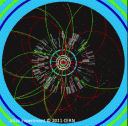Do you paint, write, dance, sing or sculpt? Are you an artist who is inspired by science? CERN may be the place for you.
The science that goes on at the laboratory has long been an inspiration for artists. One current artist you may have heard of is Kate McAlpine, otherwise known as the rap artist Alpinekat. She rose to fame with her hit Large Hadron Rap, which describes the Large Hadron Collider and its related science at CERN. Check out that video and others here.
CERN, the French acronym for the European Organization for Nuclear Research, is a high-energy physics laboratory located mostly in Switzerland. It is here that the largest accelerator in the world, the Large Hadron Collider, is located. It spans the Swiss-French border about 330 ft (100 m) underground. This instrument is essentially a ring, 88 ft (27 m) in diameter, consisting of a series of superconducting magnets. The magnets serve to accelerate subatomic particles that are then smashed together in one of several detectors, each the size of a house. The result is a spectacular computer display of brightly colored lines that look something like this:
Its easy to see why science here can inspire artists.
Just look at the movie Angels & Demons. Dan Brown was inspired by science at the lab when he wrote his book. In it, the bad guys steal a canister of antimatter from a secret underground lab at CERN, and portions of the movie were filmed at the ATLAS experiment at the lab (check out the multimedia tab on the website).
Now, with ever increasing interest in merging art and science, a new experiment is taking place at CERN. Called Great Arts for Great Science, the goal is to bring artists to the lab where they can connect with scientists and, through their art, bring science into a broader cultural setting. And broad it is. The gallery on the website shows examples of sculpture, music, photography, and dance. The organization behind the project is due to Ariane Koek, a cultural specialist dedicated to arts development at CERN. As part of the initiative, a residency program for artists at the lab is expected to launch this year, which is predicted to ease the flow of information between artists and scientists. Artists will have the opportunity to visit the lab and talk with scientists, and support their artistic work with scientific knowledge.
But do you think this inspiration moves only from scientist to artist? Surprisingly, the cultural exchange happens in both directions. Great scientists often use creative thinking in solving a particularly difficult problem. Just think of Leonardo da Vinci. During the Renaissance, there were no strong divisions between art and science as there are today. In spite of his work as an artist, da Vinci used his creativity to design various barricades, bridges and flying machines. Or consider the names of the moons orbiting around Uranus. Astronomers were inspired by the names of characters in the works of William Shakespeare and Alexander Pope. By bringing artists to CERN, scientists will have the opportunity to tap into their artistic side and think more creatively about their projects and science in general.
As the advising scientist for Great Arts for Great Science, Michael Doser says, Science can provide understanding, while art can provide meaning to the human enterprise.
By bridging art and science, we can more easily see the relevance of basic research to society and science can be allowed to engage within the larger cultural context. There is a tight relationship between art and science in that both are ways of exploring our existence: what it means to be human and where we are in the universe.

